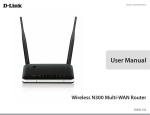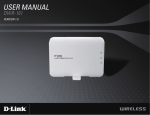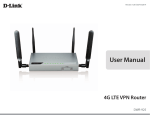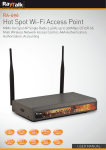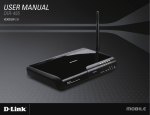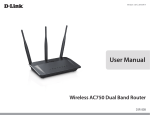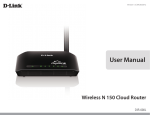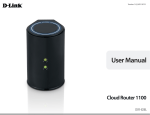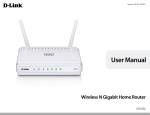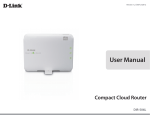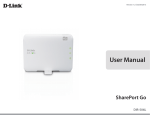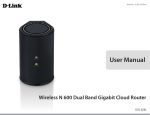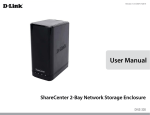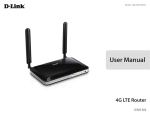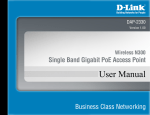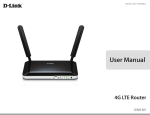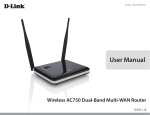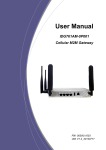Download User Manual
Transcript
Version 1.01 | 10/08/2013 User Manual Wireless N300 Multi-WAN Router DWR-116 Preface D-Link reserves the right to revise this publication and to make changes in the content hereof without obligation to notify any person or organization of such revisions or changes. Manual Revisions Revision Date 1.0 May 24, 2013 Description • Initial release for Revision A1 Trademarks D-Link and the D-Link logo are trademarks or registered trademarks of D-Link Corporation or its subsidiaries in the United States or other countries. All other company or product names mentioned herein are trademarks or registered trademarks of their respective companies. Copyright © 2013 by D-Link Corporation. All rights reserved. This publication may not be reproduced, in whole or in part, without prior expressed written permission from D-Link Corporation. D-Link DWR-116 User Manual i Table of Contents Table of Contents Preface.................................................................................. i Manual Revisions............................................................................ i Trademarks....................................................................................... i Product Overview............................................................... 1 Package Contents.......................................................................... 1 System Requirements.................................................................. 1 Introduction.................................................................................... 2 Hardware Overview...................................................................... 3 Back Panel................................................................................ 3 Front Panel and LEDs............................................................ 4 Top.............................................................................................. 5 Installation.......................................................................... 6 Connect to Your Network........................................................... 6 Wireless Installation Considerations....................................... 7 Configuration...................................................................... 8 Web-based Configuration Utility............................................. 8 Setup.................................................................................................. 9 Internet Connection Setup Wizard.................................. 9 Manual Internet Connection Setup..............................16 Internet Connection Type.................................................16 Dynamic IP (DHCP)..............................................................17 PPPoE.......................................................................................18 PPTP..........................................................................................19 L2TP..........................................................................................20 D-Link DWR-116 User Manual 3G / 4G LTE.............................................................................21 Static IP....................................................................................22 Failover Setting.....................................................................23 Wireless Connection Setup Wizard...............................24 Wireless Settings..................................................................28 Wi-Fi Protected Setup........................................................32 Network Settings.................................................................33 Router Settings................................................................33 DHCP Server Settings....................................................34 Advanced.......................................................................................35 Virtual Server.........................................................................35 Application Rules.................................................................36 QoS Engine............................................................................37 MAC Address Filter..............................................................38 URL Filter.................................................................................39 Outbound Filter....................................................................40 Inbound Filter.......................................................................41 SNMP........................................................................................42 Routing....................................................................................43 Advanced Wireless..............................................................44 Advanced Network.............................................................45 Tools.................................................................................................46 Admin......................................................................................46 Time..........................................................................................47 Syslog.......................................................................................48 Email Settings.......................................................................49 ii Table of Contents System.....................................................................................50 Firmware.................................................................................51 Dynamic DNS........................................................................52 System Check........................................................................53 Schedules...............................................................................54 Status...............................................................................................55 Device Information.............................................................55 Logs..........................................................................................56 Statistics..................................................................................57 Wireless...................................................................................58 Support...................................................................................59 Troubleshooting...............................................................80 Wireless Modes.............................................................................82 Networking Basics............................................................83 Check your IP address................................................................83 Statically Assign an IP address................................................84 Technical Specifications...................................................85 Wireless Security..............................................................60 What is WEP?.................................................................................60 Configure WEP..............................................................................61 What is WPA?.................................................................................62 Configure WPA-PSK.....................................................................63 Configure WPA (RADIUS)..........................................................64 Windows® 8....................................................................................65 WPA/WPA2.............................................................................65 Windows® 7....................................................................................67 WPA/WPA2.............................................................................67 WPS...........................................................................................69 Windows Vista®.............................................................................73 WPA/WPA2.............................................................................74 WPS/WCN 2.0........................................................................76 Windows® XP.................................................................................77 WPA/WPA2.............................................................................78 D-Link DWR-116 User Manual iii Section 1 - Product Overview Product PackageOverview Contents • D-Link DWR-116 Wireless N300 Multi-WAN Router • Power Adapter • Manual and Warranty on CD • External Wi-Fi antenna Note: Using a power supply with a different voltage rating than the one included with the DWR-116 will cause damage and void the warranty for this product. System Requirements • A compatible 3G/4G LTE USB modem Computer with the following: • Windows®, Macintosh, or Linux-based operating system • An installed Ethernet adapter Browser Requirements: • Internet Explorer® 7 and higher • Mozilla Firefox 12.0 and higher • Google™ Chrome 20.0 and higher • Apple Safari 4 and higher D-Link DWR-116 User Manual 1 Section 1 - Product Overview Introduction The D-Link Wireless N300 Multi-WAN Router allows users to access mobile broadband networks worldwide. Once connected, users can easily transfer data and stream media. Simply connect your USB modem to share your 3G/4G LTE Internet connection through a secure 802.11n wireless network or using the 10/100 Ethernet port. The Wireless N300 Multi-WAN Router can be installed quickly and easily almost anywhere. The DWR-116 is great for situations where an impromptu wireless network must be set up, or wherever conventional network access is unavailable. The DWR-116 can even be installed in buses, trains, or boats, allowing passengers to check e-mail or chat online while commuting. D-Link DWR-116 User Manual 2 Section 1 - Product Overview Hardware Overview Back Panel POWER LAN 3 LAN 1 LAN 4 LAN 2 WAN Port LAN Port WAN Port Power Port D-Link DWR-116 User Manual Function Connects to wired computers or devices. Connects to the Internet. Connects to the power adapter. 3 Section 1 - Product Overview Hardware Overview Front Panel and LEDs 3G/4G LTE Wi-Fi WPS BUTTON WAN RESET BUTTON LAN Ports 1 to 4 LED 3G/4G LTE WAN Wi-Fi LAN 1 - LAN 4 Description Color Solid Green 3G/4G LTE connection established Green WAN connection established Green Wi-Fi active and available Green Ethernet connection established Blinking Data transmitting Data transmitting Data transmitting Data transmitting Blinking (Fast) Device in WPS mode - Note: WPS mode can be activated by pressing, and holding the WPS button until the Wi-Fi LED begins to flash rapidly. You can find more details about activating WPS mode in the section titled “Wi-Fi Protected Setup” on page 39 D-Link DWR-116 User Manual 4 Section 1 - Product Overview Hardware Overview Top External Antennas USB 2.0 Port Port USB Port Antennas D-Link DWR-116 User Manual Function Connects to 3G/4G LTE Modem Dongle External WiFi Antennas 5 Section 2 - Installation Installation This section will guide you through the installation process. Placement of the router is very important. Do not place the router in an enclosed area such as a closet or cabinet, or in an attic or garage. Connect to Your Network Note: Ensure that your DWR-116 Wireless N300 Multi-WAN Router is disconnected and powered off before performing the installation steps below. 1. Connect a USB modem to the USB port located on the top of the router. 2. Insert an Ethernet network cable into the LAN port on the back of the router. Plug the other end of the Ethernet cable into the LAN port of your computer or laptop. The Ethernet LED will turn green if the Ethernet connection is successfully established. Note: The DWR-116 Wireless N300 Multi-WAN Router’s LAN ports are “Auto-MDI/MDIX.” Therefore, patch or crossover Ethernet cables can be used. 3. Configure the device using the setup utility. D-Link DWR-116 User Manual 6 Section 2 - Installation Wireless Installation Considerations The DWR-116 can be accessed using a wireless connection from virtually anywhere within the operating range of your wireless network. Keep in mind, however, that the quantity, thickness and location of walls, ceilings, or other objects that the wireless signals must pass through, may limit the range. Ranges vary depending on the types of materials and background RF (radio frequency) noise in your home or office. The key to maximizing the wireless range is to follow these basic guidelines: 1. Minimize the number of walls and ceilings between the router and other network devices. Each wall or ceiling can reduce your adapter’s range from 3 to 90 feet (1 to 30 meters). 2. Be aware of the direct line between network devices. A wall that is 1.5 feet thick (0.5 meters), at a 45-degree angle appears to be almost 3 feet (1 meter) thick. At a 2-degree angle it looks over 42 feet (14 meters) thick. Position devices so that the signal will travel straight through a wall or ceiling (instead of at an angle) for better reception. 3. Try to position access points, wireless routers, and computers so that the signal passes through open doorways or drywall. Materials such as glass, metal, brick, insulation, concrete and water can affect wireless performance. Large objects such as fish tanks, mirrors, file cabinets, metal doors and aluminum studs may also have a negative effect on range. 4. If you are using 2.4 GHz cordless phones, make sure that the 2.4 GHz phone base is as far away from your wireless device as possible. The base transmits a signal even if the phone in not in use. In some cases, cordless phones, X-10 wireless devices, and electronic equipment such as ceiling fans, fluorescent lights, and home security systems may dramatically degrade wireless connectivity. D-Link DWR-116 User Manual 7 Section 3 - Configuration Quick Setup Wizard If this is your first time installing the router, open your web browser. You will automatically be directed to the Wizard Setup Screen. If not, enter “http://dlinkrouter or http://dlinkrouter.local in the address bar”. Then, press Enter. If you have already configured your settings and you would like to access the configuration utility, please refer to If this is your first time logging into the router, this wizard will start automatically. This wizard is designed to guide you through a step-by-step process to configure your new D-Link router and connect to the Internet. There are a number of languages that can be selected by using the drop down box in the upper right hand corner of the quick start wizard. Click Next to continue. Please wait while your router detects your internet connection type. If the router detects your Internet connection, you may need to enter your ISP information such as username and password. D-Link DWR-116 User Manual 8 Section 3 - Configuration If the router does not detect a valid Ethernet connection from the Internet port, this screen will appear. Connect your broadband modem to the Internet port and then click Try Again. If the router detects an Ethernet connection but does not detect the type of Internet connection you have, this screen will appear. Click Guide me through the Internet Connection Settings to display a list of connection types to choose from. Select your Internet connection type and click Next to continue. D-Link DWR-116 User Manual 9 Section 3 - Configuration If the router detected or you selected DHCP, you may enter a MAC address and host name, click Next to continue. You may also need to click the Clone button in order to copy the MAC address from your computer. If you are unsure, check with your ISP to find out what their requirements are. If the router detected or you selected PPPoE, enter your PPPoE username and password and click Next to continue. Note: Make sure to remove your PPPoE software from your computer. The software is no longer needed and will not work through a router. D-Link DWR-116 User Manual 10 Section 3 - Configuration If the router detected or you selected PPTP, enter your PPTP username, password, and other information supplied by your ISP. Click Next to continue. If the router detected or you selected L2TP, enter your L2TP username, password, and other information supplied by your ISP. Click Next to continue. D-Link DWR-116 User Manual 11 Section 3 - Configuration If the router detected or you selected 4G LTE / 3G Connection, select whether to use auto-detection or manual configure the settings. If you choose to manually configure the settings, you will need to enter the following: Country: Select the country that your service is from. Telecom: Select the carrier from which you receive service from. 3G/4G Network: Select the network service type. Username: The username, if needed to access your service. Password: The password, if needed to access your service. Dialed Number: The number which is needed to access the service provided. Authentication: The authentication mode which is needed in order to access the service provided. APN: The APN supplied by your service provider. Pin Code: The pin code supplied by your service provider. If the router detected or you selected Static, enter the IP and DNS settings supplied by your ISP. Click Next to continue. D-Link DWR-116 User Manual 12 Section 3 - Configuration The quick setup wizard will then ask you to configure a wireless SSID for your to easily identify the wireless network that you will create with your new D-Link router. Click Next to continue. Create a Wi-Fi password (between 8-63 characters). Your wireless clients will need to have this passphrase or key entered to be able to connect to your wireless network. If you chose BEST or BETTER, select whether to use TKIP or AES encryption, then enter a password to use for your wireless network. It is recommended that you use AES if your wireless computers and devices support it, as it is more secure. If you chose GOOD, select whether to use a HEX or ASCII password, then enter a password to use for your wireless network. If you choose HEX, you will need to enter a 10 or 26 digit password using only hex characters (0-9, A-F). If you choose ASCII, the password can be between 5 to 13 alphanumeric characters. Click Next to continue. In order to secure your router, please enter a new password. Click Next to continue. D-Link DWR-116 User Manual 13 Section 3 - Configuration Select your time zone from the drop-down menu and click Next to continue. The quick setup wizard is now complete. You may now click the Connect button to save your configuration and continue. D-Link DWR-116 User Manual 14 Section 3 - Configuration Setup Internet Connection Setup Wizard The setup wizard guides you through the initial setup of your router. There are two ways to setup your Internet connection. You can use the Web-based Internet Connection Setup Wizard or you can manually configure using the Manual Internet Connection Setup wizard. This wizard will guide you through a step-by-step process to configure your D-Link router to connect to the Internet. Click Internet Connection Setup Wizard to begin. If you want to enter your settings without running the wizard, click Manual Internet Connection Setup and skip to page “Manual Internet Connection Setup” on page 22. D-Link DWR-116 User Manual 15 Section 3 - Configuration Create a new password that will be used to access the router and then click Next to continue. Click Prev to go back to the previous page or click Cancel to close the wizard. Select your time zone from the drop-down box and then click Next to continue. Click Prev to go back to the previous page or click Cancel to close the wizard. Select the Internet connection type. The connection types are explained on the following page. If you are unsure of the correct connection type, you may have to contact your Internet Service Provider (ISP). Click Prev to go back to the previous page or click Cancel to close the wizard. Note: The DWR-116 supports several kinds of WAN interfaces, allowing you to assign either a WAN or a WWAN(3G/4G LTE) connection as the backup WAN. If the Primary WAN is down or unavailable, configure the backup WAN to Enable, and all the traffic will be routed through backup WAN. This feature is called WAN Failover. You can use WAN Failover if you need redundancy to your Internet connection or any other network. D-Link DWR-116 User Manual 16 Section 3 - Configuration The subsequent configuration pages will differ depending on the selection you make during step 3 of the wizard. DHCP Connection Choose this if your Internet connection automatically provides you with an IP Address. Most cable modems use this type of (Dynamic IP connection. See page 18 for information about how to configure this type of connection. Address): Username Choose this option if your Internet connection requires a username and password to connect. Most DSL modems use this style / Password of connection. See page 18 for information about how to configure this type of connection. Connection (PPPoE): Username Choose this option if your Internet connection requires Point-to-Point Tunneling Protocol (PPTP). See page 19 for information / Password about how to configure this type of connection. Connection (PPTP): Username Choose this option if your Internet connection requires Layer 2 Tunneling Protocol (L2TP). See page 19 for information about how / Password to configure this type of connection. Connection (L2TP): 3G/4G LTE Choose this option if your Internet Setup Provider provided you with a user name and password to use with your 3G / 4G LTE Connection: enabled USB Dongle. See page 20 for information about how to configure this type of connection. Static IP Address Choose this option if your Internet Setup Provider provided you with IP Address information that has to be manually configured. Connection: See page 21 for information about how to configure this type of connection. D-Link DWR-116 User Manual 17 Section 3 - Configuration DHCP Connection (Dynamic IP Address): Mac Address: The default MAC Address is set to the Internet port’s physical interface MAC address on the broadband router. It is not recommended that you change the default MAC address unless required by your ISP. You can use the Clone button to replace the Internet port’s MAC address with the MAC address of your PC. Host Name: Enter the host name for your router or computer. Click Next to continue, Prev to go back to the previous page or click Cancel to close the wizard. Username / Password Connection (PPPoE): IP Address: Fill in if provided by your ISP. If not, keep the default value. Username: The username/account name that your ISP provides to you for PPPoE dial-up. Password: Password that your ISP provides to you for PPPoE dial-up. Service Name: (Optional) Fill in if provided by your ISP. Click Next to continue, Prev to go back to the previous page or click Cancel to close the wizard. D-Link DWR-116 User Manual 18 Section 3 - Configuration Username / Password Connection (PPTP): Address Mode: Choose Static IP only if your ISP assigns you an IP address. Otherwise, please choose Dynamic IP. PPTP IP Address: Enter the information provided by your ISP. PPTP Subnet Mask: Enter the information provided by your ISP. PPTP Gateway IP Enter the information provided by your ISP. Address: PPTP Server IP IP address of PPTP server. Address: User Name: User/account name that your ISP provides to you for PPTP dialup. Password: Password that your ISP provides to you for PPTP dial-up. Username / Password Connection (L2TP): Address Mode: Choose Static IP only if your ISP assigns you an IP address. Otherwise, please choose Dynamic IP. L2TP IP Address: Enter the information provided by your ISP. L2TP Subnet Mask: Enter the information provided by your ISP. L2TP Gateway IP Enter the information provided by your ISP. Address: L2TP Server IP IP address of PPTP server. Address: User Name: User/account name that your ISP provides to you for PPTP dialup. Password: Password that your ISP provides to you for PPTP dial-up. D-Link DWR-116 User Manual 19 Section 3 - Configuration 3G/4G LTE Connection Dial-Up Profile: Choose whether to have the router auto-detect the 3G settings necessary or to manually input the necessary values. Country: Use the dropdown menu to select which country your 3G service provider is based from. Telecom: Once you have selected the country from which your 3G provider resides in, a list of 3G service telecom providers will be available for you to choose from. 3G Network: Select the type of 3G network your provider uses. User Name: (Optional) Fill in only if requested by ISP. Password: (Optional) Fill in only if requested by ISP. Dialed Number: Enter the number to be dialed. Authentication: Select PAP, CHAP, or Auto detection. The default authentication method is Auto. APN: (Optional) Enter the APN information. PIN: Enter the PIN code used with your SIM card. D-Link DWR-116 User Manual 20 Section 3 - Configuration Static IP Address Connection IP Address: Enter the IP address assigned to your network connection. Subnet Mask: Enter the subnet mask. Gateway Address: Enter the default gateway. Primary DNS Enter the primary DNS server. Address: Secondary DNS Enter the secondary DNS server. Address You have completed the Setup Wizard. Click Connect to save your settings. A popup will appear, to confirm your settings. Click OK to save your settings. D-Link DWR-116 User Manual 21 Section 3 - Configuration Manual Internet Connection Setup Internet Connection Type Several different Internet connection types can be selected depending upon the specifications of your Internet Service Provider (ISP). My Internet Select the Internet connection type specified Connection is: by your Internet Service Provider (ISP). The corresponding settings will be displayed below. Please see the following pages for details on how to configure these different connection types. Failover Internet This connection can serve as a backup for Connection is: your default connection. Click on the Failover Setting button in order to configure this setting. Please refer to “Failover Setting” on page 23 for more details on how to configure settings. D-Link DWR-116 User Manual 22 Section 3 - Configuration Failover Setting This connection can serve as a backup for your default connection. Failover Type: This option can be set to either Load Sharing or to Failover. With Load Sharing, the data usage is distributed evenly over the two different internet connections. With Failover, the secondary Internet connection will be in standby mode, until the primary Internet connection fails. Remote Host for This option should be set to an external IP Keep Alive: address that can be used to ensure that the 3G/4G LTE connection will be kept from going offline due to inactivity. An example would be Google’s public DNS servers (8.8.8.8 or 8.8.4.4) or your Internet service providers DNS servers. Primary WAN: This will automatically be set to the connection type selected during the Internet connection Setup Wizard, or set to the My Internet Connection is option which is found on the Manual Internet Connections settings page. Secondary WAN: This can be set by clicking on Add New Rule, the available options will be shown in the drop down box that appears. Click Save Settings to save your changes, or click Don’t Save Settings to discard your changes. D-Link DWR-116 User Manual 23 Section 3 - Configuration Dynamic IP (DHCP) This section will help you to obtain IP address information automatically from your ISP. Use this option if your ISP didn’t provide you with IP address information and/or a username and password. Host Name: (Optional) Required by some ISPs. Primary DNS (Optional) Fill in with IP address of primary Server: DNS server. Secondary DNS (Optional) Fill in with IP address of secondary Server: DNS server. MTU (Maximum You may need to change the Maximum Transmission Transmission Unit (MTU) for optimal Unit): performance. The default value is 1500. MAC Address: The default MAC address is set to the Internet port’s physical interface MAC address on the broadband router. It is not recommended that you change the default MAC address unless required by your ISP. You can use the Clone button to replace the Internet port’s MAC address with the MAC address of your PC. Auto-reconnect: This feature enables this product to renew WAN IP address automatically when the lease time is expiring. Click Save Settings to save your changes, or click Don’t Save Settings to discard your changes. D-Link DWR-116 User Manual 24 Section 3 - Configuration PPPoE Choose this Internet connection if your ISP provides you with a PPPoE account. Username: The username/account name that your ISP provides to you for PPPoE dial-up. Password: Password that your ISP provides to you for PPPoE dial-up. Verify Password: Fill in with the same password in Password field. Service Name: (Optional) Fill in if provided by your ISP. IP Address: (Optional) Fill in if provided by your ISP. If not, keep the default value. Primary DNS Server: (Optional) Fill in if provided by your ISP. If not, keep the default value. Secondary DNS (Optional) Fill in if provided by your ISP. If not, keep the default value. Server: MAC Address: MAC address of WAN interface. You can also copy MAC address of your PC to its WAN interface by pressing the Clone button. The Restore MAC button will reset the router to its default MAC address. Maximum Idle Time: The amount of time of inactivity before disconnecting established PPPoE session. Setting it to zero or enabling Reconnect Mode: Always-on setting will disable this feature. MTU: You may need to change the Maximum Transmission Unit (MTU) for optimal performance. The default setting of PPPoE is 1492. Auto-reconnect: The device will dial-up PPPoE connection automatically. Click Save Settings to save your changes, or click Don’t Save Settings to discard your changes. D-Link DWR-116 User Manual 25 Section 3 - Configuration PPTP Choose this Internet connection if your ISP provides you a PPTP account. Address Mode: Choose Static IP only if your ISP assigns you an IP address. Otherwise, please choose Dynamic IP. PPTP IP Address: Enter the information provided by your ISP. (Only applicable for Static IP PPTP.) PPTP Subnet Enter the information provided by your ISP. Mask: (Only applicable for Static IP PPTP.) PPTP Gateway Enter the information provided by your ISP. IP Address: (Only applicable for Static IP PPTP.) PPTP Server IP IP address of PPTP server. Address: Username: User/account name that your ISP provides to you for PPTP dial-up. Password: Password that your ISP provides to you for PPTP dial-up. Verify Password: Fill in with the same password in Password field. Reconnect Choose Always-on when you want to establish PPTP connection all the time. If you choose Connect-on-demand, the device Mode: will establish PPTP connection when local users want to surf the Internet, and disconnect if there is no traffic after the time period set under Maximum Idle Time. Maximum Idle The time of no activity to disconnect your PPTP session. Set it to zero or choose Always-on to disable this feature. Time: Click Save Settings to save your changes, or click Don’t Save Settings to discard your changes. D-Link DWR-116 User Manual 26 Section 3 - Configuration L2TP Choose this Internet connection if your ISP provides you a L2TP account. Address Mode: Choose Static IP only if your ISP assigns you an IP address. Otherwise, please choose Dynamic IP. L2TP IP Address: Enter the information provided by your ISP. (Only applicable for Static IP L2TP.) L2TP Subnet Enter the information provided by your ISP. Mask: (Only applicable for Static IP L2TP.) L2TP Gateway IP Enter the information provided by your ISP. Address: (Only applicable for Static IP L2TP.) L2TP Server IP IP address of L2TP server. Address: Username: User/account name that your ISP provides to you for L2TP dial-up. Password: Password that your ISP provides for L2TP dial-up. Verify Password: Fill in with the same password in Password field. Reconnect Choose Always-on when you want to establish L2TP connection all the time. Choose Connect-on-demand and the device will Mode: establish L2TP connection when local users want to surf Internet, and disconnect if no traffic after time period of Maximum Idle Time. Maximum Idle The time of no activity to disconnect your L2TP session. Set it to zero or choose Always-on to disable this feature. Time: Click Save Settings to save your changes, or click Don’t Save Settings to discard your changes. D-Link DWR-116 User Manual 27 Section 3 - Configuration 3G / 4G LTE Choose this Internet connection if you already use a SIM card for 3G/4G LTE Internet service from your mobile service provider company. The fields here may not be necessary for your connection. The information on this page should only be used if required by your service provider. Dial-Up Profile: Choose whether to have the router auto-detect the 3G settings necessary or to manually input the necessary values. Country: Use the dropdown menu to select which country your 3G service provider is based from. Telecom: Once you have selected the country from which your 3G provider resides in, a list of 3G service telecom providers will be available for you to choose from. 3G Network: Select the type of 3G network your provider uses. Username: (Optional) Fill in only if requested by ISP. Password: (Optional) Fill in only if requested by ISP. Dialed Number: Enter the number to be dialed. Authentication: PAP, CHAP, or Auto detection. The default authentication method is Auto. APN: (Optional) Enter the APN information. PIN: Enter the PIN associated with your SIM card. D-Link DWR-116 User Manual 28 Section 3 - Configuration Reconnect Choose whether the device will reconnect to the 3G/4G network automatically or manually. Mode: Maximum Idle The time of no activity required to disconnect the established 3G/4G LTE session. Set it to zero or choose Auto in Reconnect Time: Mode to disable. Primary DNS (Optional) Fill in if provided by your ISP. If not, keep the default value. Server: Secondary DNS (Optional) Fill in if provided by your ISP. If not, keep the default value. Server: Keep Alive: Disable or Use LCP Echo Request. This depends on ISP requirement. Bridge Ethernet Activate this feature to change Ethernet WAN port to LAN port. Ports: D-Link DWR-116 User Manual 29 Section 3 - Configuration Static IP Choose this Internet connection if your ISP assigns you a static IP address. IP Address: Enter the IP address assigned to your network connection. Subnet Mask: Enter the subnet mask. Default Gateway: Enter the default gateway. Primary DNS Enter the primary DNS server. Server: Secondary DNS Enter the secondary DNS server. Server: MTU: You may need to change the Maximum Transmission Unit (MTU) for optimal performance. The default value is 1500. MAC Address: The default MAC Address is set to the Internet port’s physical interface MAC address on the broadband router. It is not recommended that you change the default MAC address unless required by your ISP. You can use the Clone button to replace the Internet port’s MAC address with the MAC address of your Ethernet card. Click Save Settings to save your changes, or click Don’t Save Settings to discard your changes. D-Link DWR-116 User Manual 30 Section 3 - Configuration Wireless Connection Setup Wizard This section will help you to manually configure the wireless settings of your router. Please note that changes made on this section may also need to be duplicated on your wireless devices and clients. The Wireless Settings page allows you to configure how your router connects to the Internet. There are several ways to set up your wireless connection. You can click on the Wireless Connection Setup Wizard button to start a wizard that will guide you through setting up your wireless settings. If you want to manually configure your settings, click the Manual Wireless Connection Setup button and skip to “Manual Wireless Connection Setup” on page 35. You can also set up a wireless connection to a device automatically, or configure your router automatically through Windows by clicking the Wi-Fi Protected Setup button. This is described in “Wi-Fi Protected Setup (WPS)” on page 39. D-Link DWR-116 User Manual 31 Section 3 - Configuration This wizard will guide you through a step-by-step process to configure your D-Link router’s wireless . Click Next to continue. Note: While using the wizard, you can click Prev to go back to the previous page or you can click Cancel to close the wizard. Enter a name for your wireless network, then click Next to continue. D-Link DWR-116 User Manual 32 Section 3 - Configuration Select a level of wireless security to use, then click Next to continue. If you chose BEST or BETTER, select whether to use TKIP or AES encryption, then enter a password to use for your wireless network. It is recommended that you use AES if your wireless computers and devices support it, as it is more secure. Click Next to continue. D-Link DWR-116 User Manual 33 Section 3 - Configuration If you chose GOOD, select whether to use a HEX or ASCII password, then enter a password to use for your wireless network. If you choose HEX, you will need to enter a 10 or 26 digit password using only hex characters (0-9, A-F). If you choose ASCII, the password can be between 5 to 13 alphanumeric characters. Click Next to continue. This completes the Wireless Connection Setup Wizard. Click Save to save your changes and reboot the router. D-Link DWR-116 User Manual 34 Section 3 - Configuration Wireless Settings This section will help you to manually configure the wireless settings of your router. Please note that changes made on this section may also need to be duplicated on your Wireless Client. Enable Wireless: Select this checkbox to enable wireless access. When you set this option, the following parameters take effect. Wireless Network Also known as the SSID (Service Set Identifier), this Name: is the name of your Wireless Local Area Network (WLAN). Enter a name using up to 32 alphanumeric characters. The SSID is case-sensitive. The default name is “dlink_DWR-116”. 802.11 Mode: B/G/N mixed: Enable this mode if your network contains a mix of 802.11b and 802.11g devices. G mode: Enable this mode if your network has only 802.11g devices. If you have both 802.11b and 802.11g wireless clients, disable this mode. Auto Channel Scan: Click Auto Channel Scan to automatically select the channel that it will operate on. This option is recommended because the router will choose the channel with the least amount of interference. Wireless Channel: Choose the clearest channel to help optimize the performance and coverage of your wireless network. By default the channel is set to 11. This can be changed to fit the channel setting for an existing wireless network or to customize your wireless network. Visibility Status: Select Invisible if you do not want the SSID of your wireless network to be broadcast by the DWR-116. The SSID of your router will not be seen by site survey utilities. Therefore while setting up your wireless clients, you will have to manually enter your SSID to connect to the router. D-Link DWR-116 User Manual 35 Section 3 - Configuration Security Mode: This device supports three wireless security modes, WEP, WPA-Personal, WPA-Enterprise or None. WEP is the original wireless encryption standard. WPA provides a higher level of security and WPAPersonal does not require an authentication server. When WPA-Enterprise is enabled, the router uses EAP (802.1x) to authenticate clients via a remote RADIUS server. Click Save Settings to save your changes, or click Don’t Save Settings to discard your changes. If you choose WEP, the following options will appear: Authentication: Selec t whether to use Open or Shared authentication. WEP Encryption: Select whether to use 64-bit or 128-bit encryption. Default WEP Select which WEP key (1-4) to use as the default Key: key. This will also change the WEP Key text box to that WEP key for your to configure(1-4). Set the WEP key/password for your wireless WEP Key: network. Based on whether you are using 64 or 128-bit encryption, and whether you are using a HEX or ASCII key, you will need to enter different numbers of characters for your key, as indicated below the WEP Key text box. ASCII keys may use letters and numbers only, and HEX keys may use numbers 0-9 and letters A-F only. D-Link DWR-116 User Manual 36 Section 3 - Configuration If you choose WPA-Personal, the following options will appear: WPA Mode: Select whether to use WPA2 only or WPA only. WPA2 only is the most secure, provided that all of your clients can support it. Cipher Type: Select whether to use the TKIP or AES cipher. The AES cipher is the most secure, provided that all of your clients can support it. Network Key: Enter the key/password you want to use for your wireless network. The key must be 8 to 63 characters long, and may only contain letters and numbers. D-Link DWR-116 User Manual 37 Section 3 - Configuration If you choose WPA-Enterprise, the following options will appear: WPA Mode: Select whether to use WPA2 only or WPA only. WPA2 only is the most secure, provided that all of your clients can support it. Cipher Type: Select whether to use the TKIP or AES cipher. The AES cipher is the most secure, provided that all of your clients can support it. RADIUS Server IP Enter the IP address of your RADIUS server. Address: RADIUS Server Enter the port used for your RADIUS server. Port: RADIUS Server Enter the shared secret/password for your RADIUS Shared server. Secret: D-Link DWR-116 User Manual 38 Section 3 - Configuration Wi-Fi Protected Setup Wi-Fi Protected Setup (WPS) System is a simplified method for securing your wireless network during the “Initial setup” as well as the “Add New Device” processes. The process is just as easy as pressing a button for the Push-Button Method or correctly entering an 8-digit code. Enable: Enable/disable the Wi-Fi Protected Setup feature. AP PIN: Shows the current PIN. Generate New Create a random number that is a valid PIN. This PIN: becomes the router’s PIN. You can then copy this PIN to the user interface of the wireless client. Config Mode: Select whether the router is the Enrollee or the Registrar. If this is set to enrollee, the router will try to connect to other devices. If it is set to registrar, other devices will try to connect to the router. Config Status: Displays the current state of WPS configuration. Clicking the Release button will disable any previously paired devices from connecting. You will need to reconfigure WPS on those devices to connect them again. Disable WPS-PIN This checkbox will disable pin authentication for WPS. You will have to use the push button on the router and the device you are Method: trying to connect in order to establish a WPS pairing. Config Method: Select whether the WPS authentication will use Pin code or push button method. WPS Status: Displays the current state of the router’s WPS system. Trigger: The Trigger button acts like the physical WPS push button, and will search for devices nearby that are trying to establish a WPS connection. Note: The DWR-116 has a WPS push button on the front panel that will activate WPS mode by pressing and holding the button for approximately 6 seconds. The Wi-Fi LED will begin to flash rapidly when WPS mode has been activated. D-Link DWR-116 User Manual 39 Section 3 - Configuration Network Settings Router Settings This section will help you to change the internal network settings of your router and to configure the DHCP Server settings. Router IP Enter the IP address of the router. The default Address: IP address is 192.168.0.1. If you change the IP address, you will need to enter the new IP address in your browser in order to access the web-based configuration utility. Default Subnet Enter the Subnet Mask of the router. The Mask: default subnet mask is 255.255.255.0. Local Domain Enter the local domain name for your network. Name: Click Save Settings to save your changes, or click Don’t Save Settings to discard your changes. D-Link DWR-116 User Manual 40 Section 3 - Configuration DHCP Server Settings The DWR-116 has a built-in DHCP (Dynamic Host Control Protocol) server. The DHCP server assigns IP addresses to devices on the network that request them. By default, the DHCP Server is enabled on the device. The DHCP address pool contains a range of IP addresses, which are automatically assigned to the clients on the network. Enable DHCP Select this box to enable the DHCP server on Server: your router. DHCP IP Enter the starting and ending IP address for Address Range: the server’s IP address pool. DHCP Lease The time period for the IP address lease. Enter Time: the lease time in minutes. Primary DNS IP Assign a primary DNS Server to DHCP clients. Address: Secondary DNS Assign a DNS Server to DHCP clients. IP Address: Primary WINS IP Assign a primary WINS Server to DHCP clients. Address: Secondary WINS Assign a WINS Server to DHCP clients. IP Address: Click Save Settings to save your changes, or click Don’t Save Settings to discard your changes. D-Link DWR-116 User Manual 41 Section 3 - Configuration Advanced Virtual Server The device can be configured as a virtual server so that users can access services such as Web or FTP via the public (WAN) IP address of the router. Well-known This contains a list of pre-defined services. Services: Copy to: Copies the rule to the line of the specified ID. Use schedule You may select Always On or choose the number rule: of a schedule rule that you have defined. ID: Identifies the virtual server. Server IP: Port: Enter the IP address of the computer on your local network that you want to allow the incoming service. In the next box, enter the port number that you would like to open. Enable: Select this box to enable the rule. Schedule Rule #: Specify the schedule rule number. Click Save Settings to save your changes, or click Don’t Save Settings to discard your changes. D-Link DWR-116 User Manual 42 Section 3 - Configuration Application Rules Some applications require multiple connections, such as Internet gaming, video conferencing, Internet telephony and others. These applications have difficulties working through NAT (Network Address Translation). Application Rules allow some of these applications work with the DWR-116. Popular Select from a list of popular applications. Applications: Copy to ID: Copies the predefined application rule to the line of the specified ID. ID: Identifies the rule. Trigger: The name of the trigger. Incoming Ports: Specify the incoming port for the trigger rule. Enable: Select this box to enable the rule. Click Save Settings to save your changes, or click Don’t Save Settings to discard your changes. D-Link DWR-116 User Manual 43 Section 3 - Configuration QoS Engine The QoS Engine improves your online experience by ensuring that certain applications traffic is prioritized over other network traffic, such as FTP or Web. For best performance, use the Automatic Classification option to automatically set the priority for the applications. Enable QoS Select this box to enable the QoS Packet Filter. Packet Filter: Upstream Specify the maximum upstream bandwidth here Bandwidth: (e.g. 400 kbps). ID: Identifies the rule. Local IP : Ports: Specify the local IP address and then specify the port after the colon. Remote IP : Specify the remote IP address and then the port Ports: after the colon. QoS Priority: Select Low, Normal, or High. Enable: Select a checkbox to enable the particular QoS rules individually. Click Save Settings to save your changes, or click Don’t Save Settings to discard your changes. D-Link DWR-116 User Manual 44 Section 3 - Configuration MAC Address Filter The MAC (Media Access Controller) Address Filter option is used to control network access based on the MAC Address of the network adapter. A MAC address is a unique ID assigned by the manufacturer of the network adapter. This feature can be configured to ALLOW or DENY network/Internet access. MAC Address Select this box to enable MAC filtering. Control: Connection Wireless and wired clients with C selected Control: can connect to this device and allow/deny connections from unspecified MAC addresses. Association Wireless clients with A selected can associate to Control: the wireless LAN; and allow/deny connections from unspecified MAC addresses. ID: Identifies the rule. MAC Address: Specify the MAC address of the computer to be filtered. IP Address: Specify the last section of the IP address. Wake On LAN: Click Trigger to configure Wake On LAN. C: If this box is selected, the rule will follow the connection control setting specified in MAC A: filtering settings. If this box is selected, the rule will follow the connection control setting specified in MAC filtering settings. Click Save Settings to save your changes, or click Don’t Save Settings to discard your changes. D-Link DWR-116 User Manual 45 Section 3 - Configuration URL Filter URL Filter allows you to set up a list of websites that will be blocked from users on your network. URL Filtering: Select this box to enable URL Filtering. ID: Identifies the rule. URL: Enter URL that you would like to block. Enable: Click to enable the specific URL filter. Click Save Settings to save your changes, or click Don’t Save Settings to discard your changes. D-Link DWR-116 User Manual 46 Section 3 - Configuration Outbound Filter Outbound Filter enables you to control what packets are allowed to pass through the router. Outbound filter applies on all outbound packets. Outbound Filter: Select this box to Enable the filter. Use Schedule You may select Always On or choose the Rule: number of a schedule rule that you have defined. Copy to ID: Copies the predefined filter to the specified ID ID: Identifies the filter. Source IP : Ports: Specify the local IP address and then specify the port after the colon. Destination IP : Specify the remote IP address and then the Ports: port after the colon. Enable: Select this box to enable the filter. Schedule Rule #: Specify the schedule rule number. Previous Page: Go back to the previous filter page. Next Page: Advance to the next filter page. Click Save Settings to save your changes, or click Don’t Save Settings to discard your changes. D-Link DWR-116 User Manual 47 Section 3 - Configuration Inbound Filter Inbound Filter enables you to control what packets are allowed to pass through the router. Inbound filter only applies to packets that are destined for Virtual Servers or DMZ hosts. Inbound Filter: Select this box to Enable the filter. Use Schedule You may select Always On or choose the Rule: number of a schedule rule that you have defined. Copy to ID: Copies the predefined filter to the specified ID ID: Identifies the filter. Source IP : Specify the local IP address Source Ports: Specify the local port after the colon. Destination IP : Specify the remote IP address Destination Ports: Specify the remote port after the colon. Enable: Select this box to enable the filter. Schedule Rule #: Specify the schedule rule number. Previous Page: Go back to the previous filter page. Next Page: Advance to the next filter page. Click Save Settings to save your changes, or click Don’t Save Settings to discard your changes. D-Link DWR-116 User Manual 48 Section 3 - Configuration SNMP SNMP (Simple Network Management Protocol) is a widely used network monitoring and control protocol that reports activity on each network device to the administrator of the network. SNMP can be used to monitor traffic and statistics of the DWR-116. The DWR-116 supports SNMP v1 or v2c. SNMP Local: Selec t Enabled to allow local SNMP administration. Select Disabled to disallow local SNMP administration. SNMP Remote: Selec t Enabled to allow local SNMP administration. Select Disabled to disallow local SNMP administration. Get Community: Enter the password in this field to allow “Read only” access to network administration using SNMP. You can view the network, but no configuration is possible with this setting. Set Community: Enter the password in this field to gain “Read and Write” access to the network using SNMP software. Enter up to four IP addresses of any trap targets on your network. IP 1, IP 2, IP 3, Select the SNMP version of your system. IP 4: SNMP Version: Click Save Settings to save your changes, or click Don’t Save Settings to discard your changes. D-Link DWR-116 User Manual 49 Section 3 - Configuration Routing The Routing page allows you to specify custom routes that determine how data is moved around your network. RIP: Select this box to enable routing. RIPv1: Protocol in which the IP address is routed through the Internet. RIPv2: Enhanced version of RIPv1 with added features such as authentication, routing domain, next hop forwarding, and subnetmask exchange. ID: Identifies the rule. Destination: Enter the IP of the specified network that you want to access using the static route. Subnet Mask: Enter the subnet mask to be used for the specified net work. Gateway: Enter the gateway IP address to the specified network. Hop: Enter the amount of hops it will take to reach the specified network. Enable: Select this box to enable the rule. D-Link DWR-116 User Manual 50 Section 3 - Configuration Advanced Wireless Advanced Wireless contains settings which can negatively affect the performance of your router if configured improperly. Do not change these settings unless you are already familiar with them or have been instructed to to do so. Beacon Interval: Beacons are packets sent by an Access Point to synchronize a wireless network. Specify a value. 100 is the default setting and is recommended. Transmit Power: Set the transmit power of the antennas. This value should remain at its default setting of RTS Threshold: 2347. If inconsistent data flow is a problem, only a minor modification should be made. The fragmentation threshold, which is specified Fragmentation: in bytes, determines whether packets will be fragmented. Packets exceeding the 2346 byte setting will be fragmented before transmission. 2346 is the default setting. DTIM Interval: A Delivery Traffic Indication Message (DTIM) is a countdown informing clients of the next window WMM Capable: for listening to broadcast and multicast messages. The default interval is 3. TX Rates: WMM (Wi-Fi Multimedia) is a QoS (Quality of Service) system for your wireless network. Enable this option to improve the quality of video and voice applications for your wireless clients. Select the basic transfer rates based on the speed of wireless adapters on your wireless network. It is strongly recommended to keep this setting to Auto. Click Save Settings to save your changes, or click Don’t Save Settings to discard your changes. D-Link DWR-116 User Manual 51 Section 3 - Configuration Advanced Network Advanced Network contains settings which can change the way the router handles certain types of traffic. We recommend that you do not change any of these settings unless you are already familiar with them or have been instructed to do so. Enable UPnP: Click Enable UPnP to use the Universal Plug and Play (UPnP™) feature. UPnP provides compatibility with networking equipment, software and peripherals. Enable WAN Select the box to allow the WAN port to Ping Respond: be “pinged.” Blocking the Ping option may provide some extra security from hackers. Click Save Settings to save your changes, or click Don’t Save Settings to discard your changes. D-Link DWR-116 User Manual 52 Section 3 - Configuration DMZ A firewall protects your network from the outside world. The DWR-116 offers a firewall type functionality. The Stateful Packet Inpection (SPI) feature helps prevent cyber attacks. Sometimes you may want a computer exposed to the outside world for certain types of applications. If you choose to expose a computer, you can enable DMZ. DMZ is short for Demilitarized Zone. This option will expose the chosen computer completely to the outside world. Enable SPI: SPI (Stateful Packet Inspection), also known as dynamic packet filtering, helps to prevent cyber attacks by tracking more state per session. It validates that the traffic passing through the session conforms to the protocol. Enable DMZ: If an application has trouble working from behind the router, you can expose one computer to the Internet and run the application on that computer. Note: Placing a computer in the DMZ may expose that computer to a variety of security risks. Use of this option is only recommended as a last resort. DMZ IP Address: Specify the IP address of the computer on the LAN that you want to have unrestricted Internet communication. If this computer obtains its IP address automatically using DHCP, be sure to make a static reservation on the Setup > Network Settings page so that the IP address of the DMZ machine does not change. D-Link DWR-116 User Manual 53 Section 3 - Configuration Tools Admin The Admin page allows you to change the Administrator password and enable Remote Management. The Administrator has read/write access while the user has read-only access. Only the admin has the ability to change both admin and user account passwords. New Password: Enter a password that the admin account will use to access the router’s management interface. Confirm Password: Confirm the chosen password. Remote management allows the DWR-116 to be Remote configured from the Internet using a web browser. Management: A username and password is still required to access the web-management interface. Usually only a member of your network can browse the built-in web pages to perform Administrator tasks. This feature enables you to perform Administrator tasks from the remote (Internet) host. IP Allowed to Enter the Internet IP address of the PC that has access to the broadband router. If you enter an asterisk (*) in this field, then anyone Access: will be able to access the router. Adding an asterisk (*) into this field could present a security risk and is not recommended. Port: This is the port number used to access the router. Example: 8080 is the port used for the web-management interface. Click Save Settings to save your changes, or click Don’t Save Settings to discard your changes. D-Link DWR-116 User Manual 54 Section 3 - Configuration Time This section will help you set the time zone that you are in and the NTP (Network Time Protocol) server. Daylight Saving can also be configured to adjust the time when needed. Time: Displays the current time and date of the DWR-116. Time Zone: Select the appropriate Time Zone from the drop-down box. Automatically Select this checkbox to automatically synchronize synchronize the DWR-116 with an Internet with Internet time server. time server: NTP Server Choose the NTP Server used for synchronizing Used: time and date. Sync. Result: Shows the result of the last time synchronization. Click Save Settings to save your changes, or click Don’t Save Settings to discard your changes. D-Link DWR-116 User Manual 55 Section 3 - Configuration Syslog The DWR-116 keeps a running log of events and activities occurring on the router. You may send these logs to a SysLog server on your network. Enable Logging Select this box to send the router logs to a to Syslog Server: Syslog server. Syslog Server IP Enter the address of the Syslog server that will Address: be used to send the logs. Click Save Settings to save your changes, or click Don’t Save Settings to discard your changes. D-Link DWR-116 User Manual 56 Section 3 - Configuration Email Settings Email Settings allows you to send the system log files, router alert messages, and firmware update notifications to an e-mail address. Enable E-mail When this option is enabled, router activity Notification: logs are e-mailed to a designated e-mail address. SMTP Sever IP Enter the SMTP server IP address followed and Port: by a colon and the port number (e.g. 123.123.123.1:25). SMTP Enter the SMTP username. Username: SMTP Password: Enter the SMTP password. Send E-mail Enter the e-mail address where you would like Alert to: the e-mail sent to. E-mail Subject: Enter a subject for the e-mail. E-mail Log Now: Click this button to access the e-mail log. Click Save Settings to save your changes, or click Don’t Save Settings to discard your changes. D-Link DWR-116 User Manual 57 Section 3 - Configuration System Here, you can save the current system settings onto the local hard drive. Save Settings Use this option to save your current router To Local Hard configuration settings to a file and onto your Drive: computer. Click Save to open a file dialog, and then select a location and file name for the settings. Load Settings Use this option to load the previously saved From Local Hard router configuration settings. Browse to find Drive: the saved file and then click Upload Settings to transfer those settings to the router. Restore To This option will restore all settings back to Factory Default their defaults. Any settings that have not been Settings: backed up will be lost, including any rules that you have created. D-Link DWR-116 User Manual 58 Section 3 - Configuration Firmware Here, you can upgrade the firmware of your router. Make sure the firmware you want to use is on the local hard drive of the computer and then click Browse to upload the file. Please check the D-Link support site for firmware updates at http://support. dlink.com. You can download firmware upgrades to your hard drive from the D-Link support site. Current Displays your current firmware version. Firmware Version: Current Displays your current firmware date. Firmware Date: Browse: After you have downloaded the new firmware, click Browse to locate the firmware on your computer. Tick Accept unofficial firmware if you want to update the DWR-116 with unofficial firmware (not recommended). Click Upload to start the firmware upgrade. D-Link DWR-116 User Manual 59 Section 3 - Configuration Dynamic DNS The Dynamic Domain Name System (DDNS) feature allows you to host a server (Web, FTP, or Game Server) using a domain name that you have purchased (www.whateveryournameis.com) with your dynamically assigned IP address. Sign up for D-Link’s free DDNS service at www.dlinkddns.com. Enable DDNS: DDNS is a method of keeping a domain name linked to a changing IP Address. Select this box to enable DDNS. Provider: Select your DDNS provider from the dropdown box. Host Name: Enter the Host Name that you registered with your DDNS service provider. Username / Enter the Username for your DDNS account. E-mail: Password / Key: Enter the Password for your DDNS account. Click Save Settings to save your changes, or click Don’t Save Settings to discard your changes. D-Link DWR-116 User Manual 60 Section 3 - Configuration System Check This useful diagnostic utility can be used to check if a computer is connected to the network. It sends ping packets and listens for responses from the specific host. Host Name or IP Enter a host name or the IP address that you Address: want to ping and click Ping. PING Result: The status of your Ping attempt will be displayed in the Ping Result box. D-Link DWR-116 User Manual 61 Section 3 - Configuration Schedules This section allows you to manage schedule rules for various firewall and parental control features. Enable Tick this check box to enable schedules. Schedule: Add New Rule...: Click on this button to create a new rule. The following options will be available. Edit: Edit the rule’s start and end time. Delete: Delete the rule. Name of Rule 1: Enter a name for your new schedule. Start Time Enter the time at which you would like the (hh:mm): schedule to become active. End Time Select the time at which you would like the (hh:mm): schedule to become inactive. Click Save Settings to save your changes, or click Don’t Save Settings to discard your changes. D-Link DWR-116 User Manual 62 Section 3 - Configuration Status Device Information All of your Internet and network connection details are displayed on this page. The firmware version is also displayed here. General: Displays the current time and firmware version. WAN: Displays the MAC address and the private (local) IP settings for the router. 3G/4G LTE Card: Displays 3G/4G LTE card info, link status, and the LAN: network name. Wireless LAN: Displays the MAC address and the public IP settings for the router. LAN Computers: Displays the wireless MAC address and your wireless settings such as SSID, channel, and encryption type. Also displays the list of currently connected DHCP clients. D-Link DWR-116 User Manual 63 Section 3 - Configuration Logs Here you can view logs and define events that you want to view. This router also has an internal syslog server, so you can send the log files to a computer that is running a syslog utility. D-Link DWR-116 User Manual 64 Section 3 - Configuration Statistics Here you can view the packets transmitted and received passing through your router on both WAN and LAN ports. The traffic counter will reset if the device is rebooted. D-Link DWR-116 User Manual 65 Section 3 - Configuration Wireless This table displays a list of wireless clients that are connected to your wireless router. It also displays the connection time and MAC address of the connected wireless clients. D-Link DWR-116 User Manual 66 Section 3 - Configuration Support The SUPPORT pages provide help information for each section of the device’s interface. To view the Support pages, click on SUPPORT at the top of the screen. D-Link DWR-116 User Manual 67 Section 4 - Security Wireless Security This section will show you the different levels of security you can use to protect your data from intruders. The DWR-116 offers the following types of security: • WPA2 (Wi-Fi Protected Access 2) • WPA2-PSK (Pre-Shared Key) • WPA (Wi-Fi Protected Access) • WPA-PSK (Pre-Shared Key) • WEP (Wired Equivalent Privacy) What is WEP? WEP stands for Wired Equivalent Privacy. It is based on the IEEE 802.11 standard and uses the RC4 encryption algorithm. WEP provides security by encrypting data over your wireless network so that it is protected as it is transmitted from one wireless device to another. To gain access to a WEP network, you must know the key. The key is a string of characters that you create. When using WEP, you must determine the level of encryption. The type of encryption determines the key length. 128-bit encryption requires a longer key than 64-bit encryption. Keys are defined by entering in a string in HEX (hexadecimal - using characters 0-9, A-F) or ASCII (American Standard Code for Information Interchange – alphanumeric characters) format. ASCII format is provided so you can enter a string that is easier to remember. The ASCII string is converted to HEX for use over the network. Four keys can be defined so that you can change keys easily. D-Link DWR-116 User Manual 68 Section 4 - Security Configure WEP It is recommended to enable encryption on your wireless router before your wireless network adapters. Please establish wireless connectivity before enabling encryption. Your wireless signal may degrade when enabling encryption due to the added overhead. 1. Log into the web-based configuration by opening a web browser and entering the IP address of the router (192.168.0.1). Click on Wireless Settings on the left side. 2. Next to Security Mode, select Enable WEP Security. 3. Next to Authentication, select Open or Shared Key. 4. Select either 64-bit or 128-bit encryption from the drop-down box next to WEP Encryption. 5. Next to Key Type, select either Hex or ASCII. Hex (recommended) - Letters A-F and numbers 0-9 are valid. ASCII - All numbers and letters are valid. 6. Next to Key 1, enter a WEP key that you create. Make sure you enter this key exactly on all your wireless devices. You may enter up to 4 different keys. 7. Click Save Settings to save your settings. If you are configuring the router with a wireless adapter, you will lose connectivity until you enable WEP on your adapter and enter the same WEP key as you did on the router. D-Link DWR-116 User Manual 69 Section 4 - Security What is WPA? WPA, or Wi-Fi Protected Access, is a Wi-Fi standard that was designed to improve the security features of WEP (Wired Equivalent Privacy). The 2 major improvements over WEP: • Improved data encryption through the Temporal Key Integrity Protocol (TKIP). TKIP scrambles the keys using a hashing algorithm and, by adding an integrity-checking feature, ensures that the keys haven’t been tampered with. WPA2 is based on 802.11i and uses Advanced Encryption Standard (AES) instead of TKIP. • User authentication, which is generally missing in WEP, through the extensible authentication protocol (EAP). WEP regulates access to a wireless network based on a computer’s hardware-specific MAC address, which is relatively simple to be sniffed out and stolen. EAP is built on a more secure public-key encryption system to ensure that only authorized network users can access the network. WPA-PSK/WPA2-PSK uses a passphrase or key to authenticate your wireless connection. The key is an alpha-numeric password between 8 and 63 characters long. The password can include symbols (!?*&_) and spaces. This key must be the exact same key entered on your wireless router or access point. WPA/WPA2 incorporates user authentication through the Extensible Authentication Protocol (EAP). EAP is built on a more secure public key encryption system to ensure that only authorized network users can access the network. D-Link DWR-116 User Manual 70 Section 4 - Security Configure WPA-PSK It is recommended to enable encryption on your wireless router before your wireless network adapters. Please establish wireless connectivity before enabling encryption. Your wireless signal may degrade when enabling encryption due to the added overhead. 1. Log into the web-based configuration by opening a web browser and entering the IP address of the router (192.168.0.1). Click on Wireless Settings on the left side. 2. Next to Security Mode, select Enable WPA-Personal Security or Enable WPA2-Personal Security. 3. Next to Cipher Mode, select TKIP, AES, or Auto. 4. Next to PSK/EAP, select PSK. 5. Next to Passphrase, enter a key (passphrase). The key is an alpha-numeric password between 8 and 63 characters long. The password can include symbols (!?*&_) and spaces. Make sure you enter this key exactly the same on all other wireless clients. 6. Enter the passphrase again next to Confirmed Passphrase. 7. Click Save Settings to save your settings. If you are configuring the router with a wireless adapter, you will lose connectivity until you enable WPA-PSK (or WPA2-PSK) on your adapter and enter the same passphrase as you did on the router. D-Link DWR-116 User Manual 71 Section 4 - Security Configure WPA (RADIUS) It is recommended to enable encryption on your wireless router before your wireless network adapters. Please establish wireless connectivity before enabling encryption. Your wireless signal may degrade when enabling encryption due to the added overhead. 1. Log into the web-based configuration by opening a web browser and entering the IP address of the router (192.168.0.1). Click on Wireless Settings on the left side. 2. Next to Security Mode, select Enable WPA-Personal Security or Enable WPA2-Personal Security. 3. Next to Cipher Mode, select TKIP, AES, or Auto. 4. Next to PSK/EAP, select EAP. 5. Next to RADIUS Server 1 enter the IP Address of your RADIUS server. 6. Next to Port, enter the port you are using with your RADIUS server. 1812 is the default port. 7. Next to Shared Secret, enter the security key. 8. If you have a secondary RADIUS server, enter its IP address, port, and secret key. 9. Click Apply Settings to save your settings. D-Link DWR-116 User Manual 72 Section 4 - Security Windows® 8 WPA/WPA2 It is recommended to enable wireless security (WPA/WPA2) on your wireless router or access point before configuring your wireless adapter. If you are joining an existing network, you will need to know the security key (Wi-Fi password) being used. To join an existing network, locate the wireless network icon in the taskbar, next to the time display. Wireless Icon Clicking on this icon will display a list of wireless networks which are within connecting proximity of your computer. Select the desired network by clicking on the network name. D-Link DWR-116 User Manual 73 Section 4 - Security You will then be prompted to enter the network security key (Wi-Fi password) for the wireless network. Enter the password into the box and click Next. If you wish to use Wi-Fi Protected Setup (WPS) to connect to the router, you can also press the WPS button on your router at this point to enable the WPS function. When you have established a successful connection with a wireless network, the word Connected will appear next to the name of the network to which you are connected. D-Link DWR-116 User Manual 74 Section 4 - Security Windows® 7 WPA/WPA2 It is recommended to enable wireless security (WPA/WPA2) on your wireless router or access point before configuring your wireless adapter. If you are joining an existing network, you will need to know the security key or passphrase being used. 1.Click on the wireless icon in your system tray (lower-right corner). Wireless Icon 2.The utility will display any available wireless networks in your area. D-Link DWR-116 User Manual 75 Section 4 - Security 3.Highlight the wireless connection with Wi-Fi name (SSID) you would like to connect to and click the Connect button. If you get a good signal but cannot access the Internet, check your TCP/IP settings for your wireless adapter. Refer to the Networking Basics section in this manual for more information. 4.The following window appears while your computer tries to connect to the router. 5.Enter the same security key or passphrase (Wi-Fi password) that is on your router and click Connect. You can also connect by pushing the WPS button on the router. It may take 20-30 seconds to connect to the wireless network. If the connection fails, please verify that the security settings are correct. The key or passphrase must be exactly the same as on the wireless router. D-Link DWR-116 User Manual 76 Section 4 - Security WPS The WPS feature of the DWR-116 can be configured using Windows® 7. Carry out the following steps to use Windows® 7 to configure the WPS feature: 1.Click the Start button and select Computer from the Start menu. 2.Click Network on the left side. D-Link DWR-116 User Manual 77 Section 4 - Security 3.Double-click the DWR-116 DWR-116 4.Input the WPS PIN number (displayed in the WPS window on the Router’s LCD screen or in the Setup > Wireless Setup menu in the Router’s Web UI) and click Next. D-Link DWR-116 User Manual 78 Section 4 - Security 5.Type a name to identify the network. 6.To configure advanced settings, click the icon. Click Next to continue. D-Link DWR-116 User Manual 79 Section 4 - Security 7.The following window appears while the Router is being configured. Wait for the configuration to complete. 8.The following window informs you that WPS on the router has been setup successfully. Make a note of the security key as you may need to provide this security key if adding an older wireless device to the network in the future. 9.Click Close to complete WPS setup. D-Link DWR-116 User Manual 80 Section 5 - Connecting to a Wireless Network Windows Vista® Windows Vista® users may use the built-in wireless utility. If you are using another company’s utility, please refer to the user manual of your wireless adapter for help with connecting to a wireless network. Most utilities will have a “site survey” option similar to the Windows Vista® utility as seen below. If you receive the Wireless Networks Detected bubble, click on the center of the bubble to access the utility. or Right-click on the wireless computer icon in your system tray (lower-right corner next to the time). Select Connect to a network. The utility will display any available wireless networks in your area. Click on a network (displayed using the SSID) and click the Connect button. If you get a good signal but cannot access the Internet, check you TCP/ IP settings for your wireless adapter. Refer to the Networking Basics section in this manual for more information. D-Link DWR-116 User Manual 81 Section 5 - Connecting to a Wireless Network WPA/WPA2 It is recommended to enable wireless security (WPA/WPA2) on your wireless router or access point before configuring your wireless adapter. If you are joining an existing network, you will need to know the security key or passphrase being used. 1. Open the Windows Vista® Wireless Utility by right-clicking on the wireless computer icon in your system tray (lower right corner of screen). Select Connect to a network. 2. Highlight the Wi-Fi name (SSID) you would like to connect to and click Connect. D-Link DWR-116 User Manual 82 Section 5 - Connecting to a Wireless Network 3. Enter the same security key or passphrase (Wi-Fi password) that is on your router and click Connect. It may take 20-30 seconds to connect to the wireless network. If the connection fails, please verify that the security settings are correct. The key or passphrase must be exactly the same as on the wireless router. D-Link DWR-116 User Manual 83 Section 5 - Connecting to a Wireless Network WPS/WCN 2.0 The router supports Wi-Fi protection, referred to as WCN 2.0 in Windows Vista®. The following instructions for setting this up depends on whether you are using Windows Vista® to configure the router or third party software. When you first set up the router, Wi-Fi protection is disabled and not configured. To enjoy the benefits of Wi-Fi protection, the router must be both enabled and configured. There are three basic methods to accomplish this: use Windows Vista’s built-in support for WCN 2.0, use software provided by a third party, or manually configure. If you are running Windows Vista®, log into the router and click the Enable checkbox in the Basic > Wireless section. Use the Current PIN that is displayed on the Advanced > Wi-Fi Protected Setup section or choose to click the Generate New PIN button or Reset PIN to Default button. If you are using third party software to set up Wi-Fi Protection, carefully follow the directions. When you are finished, proceed to the next section to set up the newly-configured router. D-Link DWR-116 User Manual 84 Section 5 - Connecting to a Wireless Network Windows® XP Windows® XP users may use the built-in wireless utility (Zero Configuration Utility). The following instructions are for Service Pack 2 users. If you are using another company’s utility, please refer to the user manual of your wireless adapter for help with connecting to a wireless network. Most utilities will have a “site survey” option similar to the Windows® XP utility as seen below. If you receive the Wireless Networks Detected bubble, click on the center of the bubble to access the utility. or Right-click on the wireless computer icon in your system tray (lower-right corner next to the time). Select View Available Wireless Networks. The utility will display any available wireless networks in your area. Click on a Wi-Fi network (displayed using the SSID) and click the Connect button. If you get a good signal but cannot access the Internet, check you TCP/ IP settings for your wireless adapter. Refer to the Networking Basics section in this manual for more information. D-Link DWR-116 User Manual 85 Section 5 - Connecting to a Wireless Network WPA/WPA2 It is recommended to enable WPA on your wireless router or access point before configuring your wireless adapter. If you are joining an existing network, you will need to know the WPA key being used. 1. Open the Windows® XP Wireless Utility by right-clicking on the wireless computer icon in your system tray (lower-right corner of screen). Select View Available Wireless Networks. 2. Highlight the Wi-Fi network (SSID) you would like to connect to and click Connect. D-Link DWR-116 User Manual 86 Section 5 - Connecting to a Wireless Network 3. The Wireless Network Connection box will appear. Enter the WPA-PSK Wi-Fi password and click Connect. It may take 20-30 seconds to connect to the wireless network. If the connection fails, please verify that the WPA-PSK settings are correct. The Wi-Fi password must be exactly the same as on the wireless router. D-Link DWR-116 User Manual 87 Section 6 - Troubleshooting Troubleshooting This chapter provides solutions to problems that can occur during the installation and operation of the DWR-116. Read the following descriptions if you are having problems. (The examples below are illustrated in Windows® XP. If you have a different operating system, the screenshots on your computer will look similar to the following examples.) 1. Why can’t I access the web-based configuration utility? When entering the IP address of the D-Link router (192.168.0.1 for example), you are not connecting to a website on the Internet or have to be connected to the Internet. The device has the utility built-in to a ROM chip in the device itself. Your computer must be on the same IP subnet to connect to the web-based utility. • Make sure you have an updated Java-enabled web browser. We recommend the following: • Internet Explorer 6.0 or higher • Netscape 8 or higher • Mozilla 1.7.12 (5.0) or higher • Opera 8.5 or higher • Safari 1.2 or higher (with Java 1.3.1 or higher) • Camino 0.8.4 or higher • Firefox 1.5 or higher • Verify physical connectivity by checking for solid link lights on the device. If you do not get a solid link light, try using a different cable or connect to a different port on the device if possible. If the computer is turned off, the link light may not be on. • Disable any internet security software running on the computer. Software firewalls such as Zone Alarm, Black Ice, Sygate, Norton Personal Firewall, and Windows® XP firewall may block access to the configuration pages. Check the help files included with your firewall software for more information on disabling or configuring it. D-Link DWR-116 User Manual 88 Section 6 - Troubleshooting • Configure your Internet settings: • Go to Start > Settings > Control Panel. Double-click the Internet Options Icon. From the Security tab, click the button to restore the settings to their defaults. • Click the Connection tab and set the dial-up option to Never Dial a Connection. Click the LAN Settings button. Make sure nothing is checked. Click OK. • Go to the Advanced tab and click the button to restore these settings to their defaults. Click OK three times. • Close your web browser (if open) and open it. • Access the web management. Open your web browser and enter the IP address of your D-Link router in the address bar. This should open the login page for your the web management. • If you still cannot access the configuration, unplug the power to the router for 10 seconds and plug back in. Wait about 30 seconds and try accessing the configuration. If you have multiple computers, try connecting using a different computer. 2. What can I do if I forgot my password? If you forgot your password, you must reset your router. Unfortunately this process will change all your settings back to the factory defaults. To reset the router, locate the reset button (hole) on the rear panel of the unit. With the router powered on, use a paperclip to hold the button down for 10 seconds. Release the button and the router will go through its reboot process. Wait about 30 seconds to access the router. The default IP address is 192.168.0.1. When logging in, the username is admin and leave the password box empty. D-Link DWR-116 User Manual 89 Appendix A - Wireless Basics Wireless Modes There are basically two modes of networking: • Infrastructure – All wireless clients will connect to an access point or wireless router. • Ad-Hoc – Directly connecting to another computer, for peer-to-peer communication, using wireless network adapters on each computer, such as two or more WNA-2330 wireless network Cardbus adapters. An Infrastructure network contains an Access Point or wireless router. All the wireless devices, or clients, will connect to the wireless router or access point. An Ad-Hoc network contains only clients, such as laptops with wireless cardbus adapters. All the adapters must be in Ad-Hoc mode to communicate. D-Link DWR-116 User Manual 90 Appendix B - Networking Basics Networking Basics Check your IP address After you install your new D-Link adapter, by default, the TCP/IP settings should be set to obtain an IP address from a DHCP server (i.e. wireless router) automatically. To verify your IP address, please follow the steps below. Click on Start > Run. In the run box type cmd and click OK. (Windows® Vista™ users type cmd in the Start Search box.) At the prompt, type ipconfig and press Enter. This will display the IP address, subnet mask, and the default gateway of your adapter. If the address is 0.0.0.0, check your adapter installation, security settings, and the settings on your router. Some firewall software programs may block a DHCP request on newly installed adapters. D-Link DWR-116 User Manual 91 Appendix B - Networking Basics Statically Assign an IP address If you are not using a DHCP capable gateway/router, or you need to assign a static IP address, please follow the steps below: Step 1 Windows® Vista™ - Click on Start > Control Panel > Network and Internet > Network and Sharing Center > Manage Network Connections. ® Windows XP - Click on Start > Control Panel > Network Connections. Windows® 2000 - From the desktop, right-click My Network Places > Properties. Step 2 Right-click on the Local Area Connection which represents your network adapter and select Properties. Step 3 Highlight Internet Protocol (TCP/IP) and click Properties. Step 4 Click Use the following IP address and enter an IP address that is on the same subnet as your network or the LAN IP address on your router. Example: If the router´s LAN IP address is 192.168.0.1, make your IP address 192.168.0.X where X is a number between 2 and 99. Make sure that the number you choose is not in use on the network. Set Default Gateway the same as the LAN IP address of your router (192.168.0.1). Set Primary DNS the same as the LAN IP address of your router (192.168.0.1). The Secondary DNS is not needed or you may enter a DNS server from your ISP. Step 5 Click OK twice to save your settings. D-Link DWR-116 User Manual 92 Appendix C - Technical Specifications Technical Specifications Data Rates ** 300,150,135,120,90,60,45,30,15 Mbps in 802.11n mode 6/9/11/12/18/24/36/48/54Mbps in 802.11g mode 1/2/5.5/11Mbps in 802.11b mode Standards IEEE 802.11n compliant (2Tx2R) IEEE 802.11b/g IEEE 802.3 IEEE 802.3u Frequency 2.4 - 2.4835 GHz Wireless Security Antenna 2 x External 5 dBiWi-Fi antenna LED Status Indicators 3G / 4G LTE WAN Wi-Fi LAN 1, LAN 2, LAN 3, LAN 4 Power External 5 V DC 2 A power adapter Dimensions (L x W x H) • 148.5 x 113.5 x 25 mm (5.85 x 4.47 x .98 inches) 64/128-bit WEP (Wired Equivalent Privacy) WPA & WPA2 (Wi-Fi Protected Access) Operating Temperature Firewall Operating Humidity IP Filtering Network Address Translation (NAT) MAC Filtering Operating: 0 to 40 °C (32 to 104 °F) Operating: 10% to 95% non-condensing VPN L2TP/PPTP/IPSEC VPN Pass-through Ports 4 x LAN (RJ-45) 1x WAN 1 x USB D-Link DWR-116 User Manual 93 Federal Communication Commission Interference Statement This device complies with Part 15 of the FCC Rules. Operation is subject to the following two conditions: (1) this device may not cause harmful interference and (2) this device must accept any interference received, including interference that may cause undesired operation You are cautioned that changes or modifications not expressly approved by the party responsible for compliance could void your authority to operate the equipment. This equipment has been tested and found to comply with the limits for a lass B digital device, pursuant to Part 15 of the FCC Rules. These limits are designed to provide reasonable protection against harmful interference in a residential installation. This equipment generates, uses and can radiate radio frequency energy and, if not installed and used in accordance with the instructions, may cause harmful interference to radio communications. However, there is no guarantee that interference will not occur in a particular installation. If this equipment does cause harmful interference to radio or television reception, which can be determined by turning the equipment off and on, the user is encouraged to try to correct the interference by one or more of the following measures: - Reorient or relocate the receiving antenna. - Increase the separation between the equipment and receiver. - Connect the equipment into an outlet on a circuit different from that to which the receiver is connected. - Consult the dealer or an experienced radio/TV technician for help. IMPORTANT NOTE: FCC Radiation Exposure Statement: This equipment complies with FCC radiation exposure limits set forth for an uncontrolled environment. This equipment should be installed and operated with minimum distance 20cm between the radiator & your body. D-Link DWR-116 User Manual 94


































































































